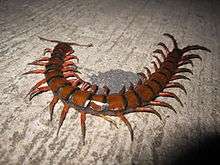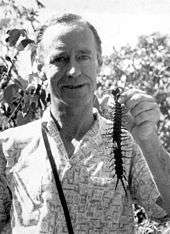Scolopendra gigantea
| Scolopendra gigantea | |
|---|---|
 | |
| Scientific classification | |
| Kingdom: | Animalia |
| Phylum: | Arthropoda |
| Subphylum: | Myriapoda |
| Class: | Chilopoda |
| Order: | Scolopendromorpha |
| Family: | Scolopendridae |
| Genus: | Scolopendra |
| Species: | S. gigantea |
| Binomial name | |
| Scolopendra gigantea Linnaeus, 1758 | |
Scolopendra gigantea, also known as the Peruvian giant yellow-leg centipede or Amazonian giant centipede, is one of the largest centipedes of the genus Scolopendra with a length up to 30 cm (12 in).[1] This species is found in various places in South America and the Caribbean, where it preys on a great variety of animals, including other sizable arthropods, amphibians, mammals and reptiles.[2]
Description

The Peruvian giant centipede is among the largest species of centipedes, regularly reaching 26 cm (10 in) in length, and sometimes 30 cm (12 in) or more.[1]
Distribution and habitat
It is naturally found in northern South America. Countries from which verified museum specimens have been collected include Aruba, Curaçao, Colombia, Venezuela (including Margarita Island) and Trinidad.[1] Records from Saint Thomas, U.S. Virgin Islands, Haiti, Dominican Republic, Puerto Rico, Mexico and Honduras are assumed to be accidental introductions or labeling errors.[1]
Scolopendra gigantea can be found in tropical or sub-tropical rainforest and tropical dry forest.
Behavior and diet
It is a carnivore that feeds on any other animal it can overpower and kill. It is capable of overpowering not only other invertebrates such as insects and even tarantulas, but also small vertebrates including small lizards, frogs (up to 95 mm long), snakes (up to 25 cm long), sparrow-sized birds, mice, and bats.[2] Large individuals of S. gigantea have been known to employ unique strategies to catch bats in which they can climb cave ceilings and hold or manipulate their heavier prey with only a few legs attached to the ceiling.[2]
Venom
In Venezuela there is a documented case of a four-year-old child's death attributed to the venom.[3]
References
- 1 2 3 4 R. M. Shelley & S. B. Kiser (2000). "Neotype designation and a diagnostic account for the centipede, Scolopendra gigantea L. 1758, with an account of S. galapagoensis Bollman 1889 (Chilopoda Scolopendromorpha Scolopendridae)". Tropical Zoology. 13 (1): 159–170.
- 1 2 3 J. Molinari, E. E. Gutiérrez, A. A. de Ascenção, J. M. Nassar, A. Arends & R. J. Márquez (2005). "Predation by giant centipedes, Scolopendra gigantea, on three species of bats in a Venezuelan cave" (PDF). Caribbean Journal of Science. 41 (2): 340–346.
- ↑ In Spanish - Diario El Tiempo Venezuela
External links
 Media related to Scolopendra gigantea at Wikimedia Commons
Media related to Scolopendra gigantea at Wikimedia Commons